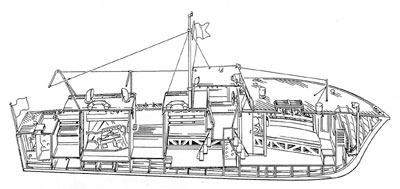
The hulls of the River class FLs were of double diagonal construction from African Mahogany. The frames were of Spruce and other members were of Canadian Rock Elm. Intercostals in the main were of Mahogany. The hulls were built up of a framework which itself was a rigid structure without the skin, thus gaining maximum strength for minimum weight. The boats were of jigged construction, ensuring that every boast was an accurate reproduction of the designed hull and also keeping production costs down. This type of construction also made later repairs very easy. The British Power Boat Co used a method of constructing hulls inverted (keel uppermost) as a complete rigid structure, before the double diagonal skin was added. The River class construction comprised 5 main compartments divided by 4 watertight bulkheads. The five compartments were the fore peak, the forward accommodation (mess) with the central accommodation (cabin) and wheelhouse and well deck, the engine room and aft cockpit and lastly the aft peak. From the keel 23 main frames, the transom and the stem, which was scarfed into the keel, provided the strength along with the intercostals and the watertight bulkheads. The main hull was then covered in double diagonal mahogany and the decks were fitted in herring bone style mahogany planking.
The resulting design and construction provided a high forecastle deck under which were the forepeak, crews mess, galley and toilet. Aft of this the central wheelhouse had access forward to the crew mess area, access aft into the central passenger accommodation and access to the side decks which were stepped down from the forecastle. Immediately aft of the passenger cabin was a small central open cockpit. The engine room was designed for twin Perkins S6M diesels and had access doors at the rear of the compartment leading to the aft cockpit. The stern of the boat comprised the fuel tank and the aft peak. Each compartment (except the fore and aft peaks) was decked out with watertight floors, under which the spaces remained void thus adding to the residual buoyancy of the boat.
HUMBER
FL HUMBER was officially commissioned into the War Department fleet on the 1st November 1946, and with an overall grey livery was briefly in RASC Water Transport home waters service. Early in 1947 she was allocated for Far East Theatre service and was slung onto delivery cradles and craned onto the deck of a mercantile cargo vessel for a four week passage to Malaya. On arrival at Port Swettenham, Malaya, she was towed ashore, complete with cradle, and then cleaned up to ready her for service; - weeks of greasy soot accumulation from the freighters funnel had to be removed, the inhibitors for the engines had to be removed, and the boat removed from the cradle. The hull was repainted and after sea trials she remained in service at Port Swettenham but officially part of 986 Water Transport Company, RASC, Singapore. After several months on patrols, mainly around the base, but also occasionally incorporating trips to neighbouring Penang or Port Dixon, the HUMBER was adopted by General & Mrs Ritchie. They used to send the crew books, and following a trip on board, a full set of ship's crockery. The Ritchie's also supplied the craft a small fridge which ran on Kerosene, thus allowing the crew a rare and most appreciated extra facility in the heat of the tropics.
On the 28th September 1949 HUMBER was transferred to 79 Coy RASC WT to be stationed at Sham Shui Po, Hong Kong. Part of the Sham Shui Po complex comprised the infamous former Japanese POW camp. At this stage 79 Coy had only recently re-formed from 1874 WT Coy, which itself was a descendant of the platoon which had been established after the Colony had been re-taken at the end of WWII. In the early 1950's HUMBER was redesignated as a FMB in keeping with "Navy Speak" at the base HMS Tamar. The crew then comprised 5, a Sergeant coxswain, an engineer and three locally enlisted personnel (LEPs) as deck hands. The HUMBER was kept in very good condition and modified with extra equipment to serve as a VIP launch. She was permanently assigned to the General Officer Commanding (GOC) Hong Kong, Major General G.C. Cruddas who entertained many distinguished visitors in the area.
Go back to page 1 | Go to page 3